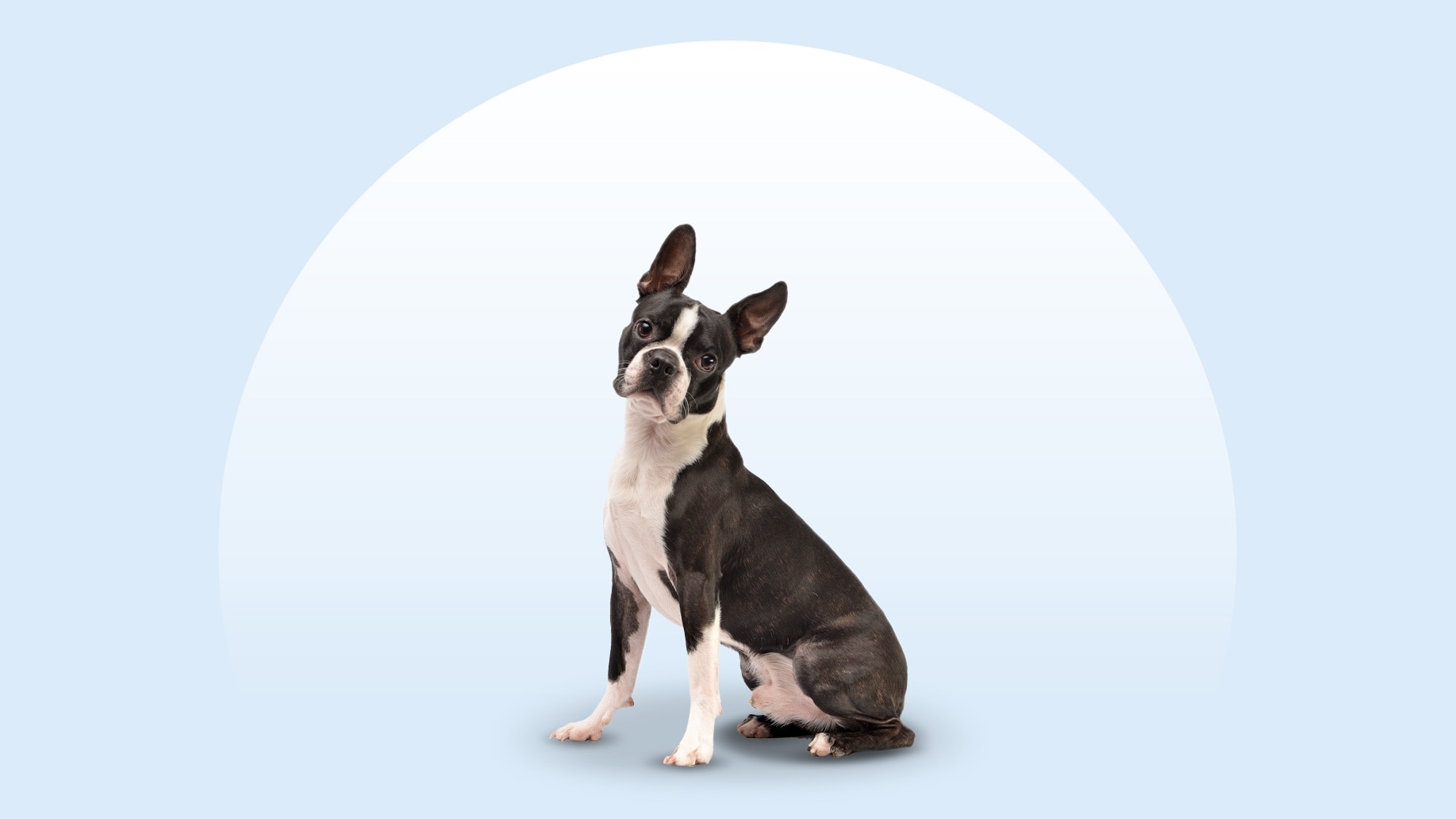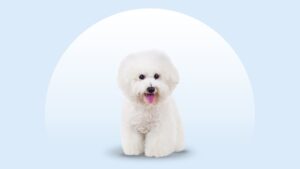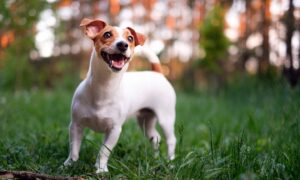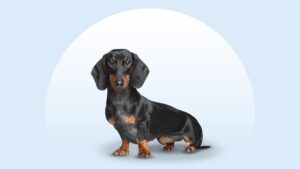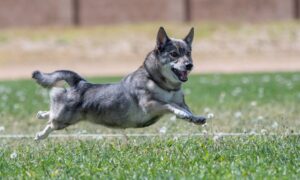Boston Terrier
Updated June 4, 2025
Boston Terrier
Updated June 4, 2025
With their dapper tuxedo coat, a Boston Terrier is always dressed for a party. They’re a good match for anyone looking for a dog to always be by their side, as Boston Terriers are well-rounded pups who enjoy sports, snuggling, playdates, and almost any other activity you can imagine.
Bubbly, Happy-Go-Lucky, Outgoing
12–25 pounds
10–12 inches
11–13 years
Black and White, Black Brindle and White, Brindle and White, Seal and White, Seal Brindle and White
Your social calendar will be full of playdates with this “American gentleman.” As their nickname suggests, the Boston Terrier’s bubbly personality easily wins over other dogs and people alike. But don’t worry—you’re still the one they want to cuddle with at the end of the day.
These social butterflies are perfect for pet parents who don’t like to be alone, because Boston Terriers will always be by your side. Don’t even think about hiding in the bathroom—they’ll find you anywhere.
Boston Terrier Characteristics
Boston Terrier Appearance
Boston Terriers are known for their goofy grin, short snout, and big, bright eyes. Short and compact, they have a slightly arched neck and floppy ears as puppies. By the time they’re around 4 months old, their ears usually stand up on their own; however, some may flop over at the tip and some always stay floppy.
Boston Terriers come in three colors with white markings that make it look like they’re always wearing a tuxedo.
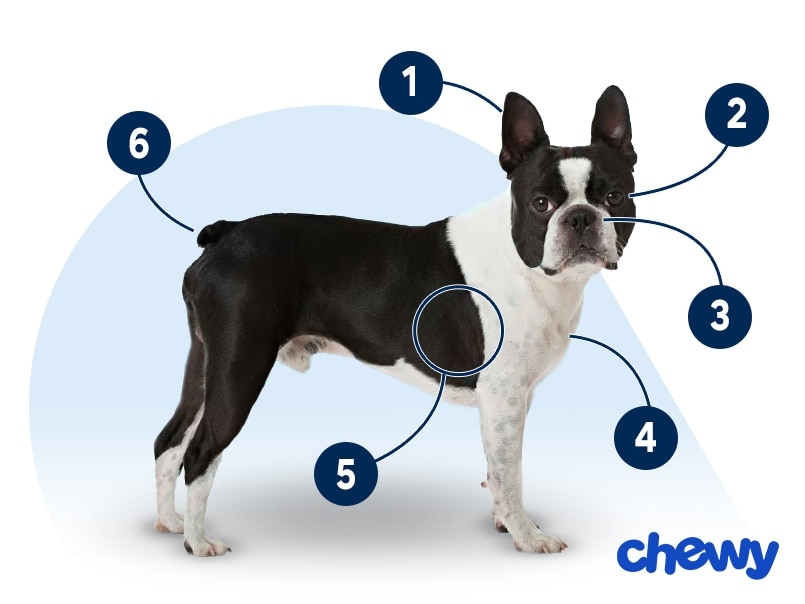
- Ears
Boston Terrier ears are small and can be alert, floppy, or alert with a little flop at the tip. While it was once common to crop (or cut) their ears, nowadays many of these pups have their ears intact. Many groups, including the American Veterinary Medical Association, oppose ear cropping, and many countries and U.S. states have banned the practice.
- Eyes
Their eyes are dark, large, and round, and they’re set wide apart.
- Nose
Their noses are black and round with a well-defined line between their nostrils.
- Coat Length
Their coats are short and smooth.
- Coat Color
The Boston Terrier often has one of three main colors: brindle (reddish with black stripes), seal (black with a reddish tint that shows up in sunlight or bright light), or black. All coat colors have white markings on the nose, between the eyes, and the chest.
- Tail
A Boston Terrier tail is low and short; it’s either straight or curly like a corkscrew.
Boston Terrier Temperament
Boston Terriers are big personalities stuck in a tiny body. These confident, self-assured pups are essentially walking rays of sunshine who brighten everyone’s day.
Full of personality and pluck, they’re super attached to their people and believe life is meant to be enjoyed. Friendly, highly affectionate, and easygoing, Boston Terriers take their role as a companion seriously and don’t like to be left alone.
Their exuberant personality can be overwhelming for shy dogs, so it’s important to socialize your Boston Terrier as early as possible and teach them how to hang out with other pups, especially more reserved ones. A well-socialized Boston Terrier loves everyone and everything, including cats and kids. Luckily, Boston Terriers are bright, curious, and love to learn, so they’re easy to train.
How to Care for a Boston Terrier
This short-haired breed is the definition of low-maintenance grooming, which means you can spend all that extra time saved snuggling, playing, and giving your dog the best life possible.
Grooming
Training
Diet
Exercise
Environment
Boston Terrier Health
The Boston Terrier lifespan is 11–13 years, but pet parents should be aware of some health issues.
- Brachycephalic obstructive airway syndrome: Also known as BOAS, this condition is caused by the Boston Terrier’s smooshed anatomy. Brachycephalic breeds, also known as flat-faced dogs, may have difficulty breathing during exercise—or even at rest. Their anatomy causes narrow nostrils and airways, along with an elongated soft palate. To manage symptoms, keep your dog at a healthy weight and avoiding extreme temperatures (both heat and cold); severe cases could require surgery.
- Cataracts: This breed can get cataracts as they age, but juvenile cataracts can show up earlier, when Boston Terriers puppies are 8–12 weeks old. Cataracts aren’t usually painful, but they cause vision loss. Get a yearly eye test to catch cataracts early. Surgery may be a treatment option.
- Corneal ulcers: Corneal ulcers are one of the most common eye problems in Boston Terriers. Because their eyes are large and stick out a bit, they’re more susceptible to scratching their cornea, which can cause a secondary bacterial infection (conjunctivitis). Corneal ulcers are very painful for dogs; depending on the severity, they can be treated with an oral antibiotic, an antibiotic ointment, or surgery.
- Glaucoma: Glaucoma occurs when fluid in the eyes doesn’t drain and builds pressure. It’s painful and can result in blindness, so it’s a medical emergency. Glaucoma can be genetic in Boston Terriers, and there is a screening test. Treatment is topical medications or surgery.
- Luxating patella: Boston Terriers can develop a luxating patella, where the kneecap slips out of place. A little bunny hop or skip while walking could be a symptom. It may be treated with supplements and meds, if mild, though surgery may be necessary.
Boston Terrier History
The Boston Terrier’s origins are in Liverpool, England, where they were bred as a cross between a Bulldog and the now-extinct English Terrier.
One of these dogs, named Judge, was brought to the United States and sold to Robert C. Hooper in Boston. The pup became known as Hooper’s Judge and is the ancestor of all modern Boston Terriers.
The breed—also sometimes referred to as “America’s gentleman” because of their tuxedo coats—became known as the Boston Terrier when the Boston Terrier Club of America formed in 1891. In 1893, the American Kennel Club recognized the breed. They’re hometown favorites, too, as the mascot of Boston University and the state dog of Massachusetts.
If you’re thinking about bringing home your own Boston Terrier puppy, work with a reputable breeder who prioritizes the health of their dogs. You can also look for a Boston Terrier for adoption at a breed-specific rescue like the Northeast Boston Terrier Rescue, at your local animal shelter or rescue organization, or via Chewy’s database of adoptable dogs in your area.
